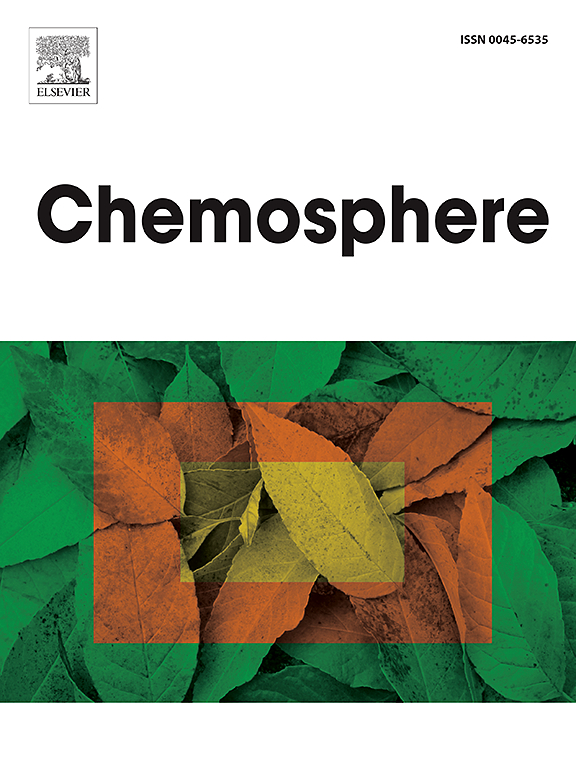Marine microalgae – Mediated biodegradation of polystyrene microplastics: Insights from enzymatic and molecular docking studies
IF 8.1
2区 环境科学与生态学
Q1 ENVIRONMENTAL SCIENCES
引用次数: 0
Abstract
Biodegradation of microplastics (MPs) through microalgal strains would be of eco-friendly approach for significant pollution abatement. Polystyrene (PS) is a major contaminant in the marine environment; however studies on marine microalgal degradation of PS MPs have been very limited. In the present study, six marine microalgal strains viz. Picochlorum maculatum, Dunaliella salina, Amphora sp., Navicula sp., Synechocystis sp. and Limnospira indica were investigated for their ability to degrade PS MPs for the incubation period of 45 days. Results from weight reduction, ATR-FTIR, SEM, and molecular docking analysis confirmed that microalgae formed biofilms on PS MPs, causing structural changes, and laccase-driven enzymatic breakdown. A maximum weight loss of 23.2 ± 0.21% and a minimum of 11.3 ± 0.026% were caused by the colonized microalgae Synechocystis sp. and Amphora sp. respectively. The study indicated that a higher reduction rate was observed in the Synechocystis sp. Treated PS MPs with a rate of 0.0058 g/day and a lower half-life of 119.34 days. SEM analysis showed that microalgae caused pits, erosion, and damage to the PS film. ATR-FTIR confirmed the chemical modifications and proved biodegradation. Laccase enzyme activity was higher in Synechocystis sp., and molecular docking showed the laccase interaction with the derivatives of PS, elucidating the breakdown process. This study highlights the potential of microalgae for eco-friendly microplastic degradation and paves the way for future research on the by-products of this process. Exploring the ecological impact of by-products and optimizing scalable methods can further enhance the sustainability and practical applications of this promising solution.

海洋微藻介导的聚苯乙烯微塑料的生物降解:从酶和分子对接研究的见解。
利用微藻菌株对微塑料进行生物降解是一种生态友好的方法,可以显著减少污染。聚苯乙烯(PS)是海洋环境中的主要污染物;然而,关于海洋微藻降解PS MPs的研究非常有限。本研究对6种海洋微藻(Picochlorum maculatum, Dunaliella salina, Amphora sp., Navicula sp., Synechocystis sp., Limnospira indica)降解PS MPs的能力进行了为期45天的研究。失重、ATR-FTIR、SEM和分子对接分析结果证实,微藻在PS MPs上形成生物膜,引起结构变化,并引起漆酶驱动的酶分解。定殖微藻聚囊藻(Synechocystis sp.)和双藻(Amphora sp.)的最大失重率分别为23.2±0.21%和11.3±0.026%。研究表明,聚囊藻处理后的PS MPs还原率较高,为0.0058 g/d,半衰期较低,为119.34 d。SEM分析表明,微藻对PS膜造成凹坑、侵蚀和破坏。ATR-FTIR证实了化学修饰和生物降解。Synechocystis sp.中漆酶活性较高,分子对接显示漆酶与PS衍生物相互作用,阐明了其分解过程。该研究突出了微藻在生态微塑料降解方面的潜力,并为该过程的副产品的进一步研究铺平了道路。探索副产品的生态影响和优化可扩展的方法可以进一步提高这一有前途的解决方案的可持续性和实际应用。
本文章由计算机程序翻译,如有差异,请以英文原文为准。
求助全文
约1分钟内获得全文
求助全文
来源期刊

Chemosphere
环境科学-环境科学
CiteScore
15.80
自引率
8.00%
发文量
4975
审稿时长
3.4 months
期刊介绍:
Chemosphere, being an international multidisciplinary journal, is dedicated to publishing original communications and review articles on chemicals in the environment. The scope covers a wide range of topics, including the identification, quantification, behavior, fate, toxicology, treatment, and remediation of chemicals in the bio-, hydro-, litho-, and atmosphere, ensuring the broad dissemination of research in this field.
 求助内容:
求助内容: 应助结果提醒方式:
应助结果提醒方式:


